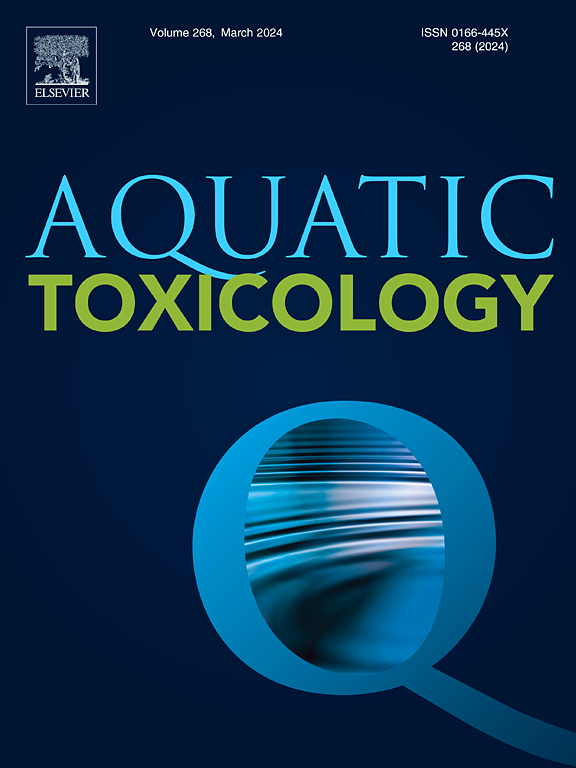The diving beetle, Cybister lateralimarginalis (De Geer, 1774), as a bioindicator for subcellular changes affected by heavy metal(loid) pollution in freshwater ecosystems
IF 4.1
2区 环境科学与生态学
Q1 MARINE & FRESHWATER BIOLOGY
引用次数: 0
Abstract
The present study assessed Cybister lateralimarginalis as a model species for ecotoxicological studies of metal(loid) bioaccumulation in freshwater ecosystems, by optimising protocols and analysing biomarker activities and metal(loid) concentrations from different sites and investigating their association. To accomplish this, levels of arsenic (As), selenium (Se), cadmium (Cd), mercury (Hg), and lead (Pb) were analysed, as well as a set of biomarkers were evaluated, esterase activity and oxidative stress biomarkers: fluorescence- and glutathione-based. C. lateralimarginalis were sampled in the spring/summer of 2023 along the Sava, Drava and Danube floodplains in Croatia. C. lateralimarginalis samples from Sava floodplain (Mužilovčica) showed altered carboxylesterase (CES) activity, lower glutathione (GSH) levels, and elevated Hg and As concentrations. The Weighted Pollution Index (WPI) indicated moderate pollution at the Sava floodplain, possibly due to agricultural or petrochemical impacts. At the Drava floodplain (Podravlje), higher glutathione S-transferase (GST) activity and elevated Cd, Hg, and As concentrations were observed, likely from soil accumulation, while Stara Drava beetles had lower GSH levels, suggesting agricultural impacts. Despite this, the Drava floodplain showed the lowest WPI. Higher GST activity was noted at the Danube floodplain (Kopački rit and Topoljski Dunavac), with reactive oxygen species (ROS) concentrations (Kopački rit and Podunavlje) possibly reflecting agricultural practices or illegal hunting. The present research successfully applied C. lateralimarginalis as a bioindicator species for assessing metal(loid)s in different environments, highlighting its reliability as an abundant apex predator, emphasizing the significance of integrating biomarker response evaluation into pollutant monitoring for efficient environmental risk assessment in freshwater ecosystems.
潜水甲虫Cybister lateralimarginalis (De Geer, 1774)作为淡水生态系统中受重金属污染影响的亚细胞变化的生物指标
本研究通过优化方案,分析不同地点的生物标志物活性和金属(样物质)浓度,并调查它们之间的关系,评估了侧arginalis作为淡水生态系统中金属(样物质)生物积累生态毒理学研究的模式物种。为了实现这一目标,分析了砷(As)、硒(Se)、镉(Cd)、汞(Hg)和铅(Pb)的水平,并评估了一系列生物标志物,酯酶活性和氧化应激生物标志物:基于荧光和谷胱甘肽。于2023年春夏在克罗地亚萨瓦河、德拉瓦河和多瑙河洪泛平原取样了侧缘草。萨瓦河漫滩(Mužilovčica)样品显示羧酸酯酶(CES)活性改变,谷胱甘肽(GSH)水平降低,汞和砷浓度升高。加权污染指数(WPI)显示萨瓦河漫滩的污染程度为中等,可能是由于农业或石化的影响。在德拉瓦洪泛平原(Podravlje),观察到较高的谷胱甘肽s -转移酶(GST)活性和升高的Cd, Hg和As浓度,可能来自土壤积累,而Stara Drava甲虫的谷胱甘肽s -转移酶水平较低,表明农业影响。尽管如此,德拉瓦洪泛区的WPI最低。在多瑙河洪泛区(kopa ki rit和Topoljski Dunavac)发现较高的GST活动,活性氧(ROS)浓度(kopa ki rit和Podunavlje)可能反映了农业实践或非法狩猎。本研究成功地将侧边藻作为评价不同环境中金属(样物质)的生物指示物种,突出了侧边藻作为丰富的顶端捕食者的可靠性,强调了将生物标志物响应评价纳入污染物监测对淡水生态系统环境风险有效评价的意义。
本文章由计算机程序翻译,如有差异,请以英文原文为准。
求助全文
约1分钟内获得全文
求助全文
来源期刊

Aquatic Toxicology
环境科学-毒理学
CiteScore
7.10
自引率
4.40%
发文量
250
审稿时长
56 days
期刊介绍:
Aquatic Toxicology publishes significant contributions that increase the understanding of the impact of harmful substances (including natural and synthetic chemicals) on aquatic organisms and ecosystems.
Aquatic Toxicology considers both laboratory and field studies with a focus on marine/ freshwater environments. We strive to attract high quality original scientific papers, critical reviews and expert opinion papers in the following areas: Effects of harmful substances on molecular, cellular, sub-organismal, organismal, population, community, and ecosystem level; Toxic Mechanisms; Genetic disturbances, transgenerational effects, behavioral and adaptive responses; Impacts of harmful substances on structure, function of and services provided by aquatic ecosystems; Mixture toxicity assessment; Statistical approaches to predict exposure to and hazards of contaminants
The journal also considers manuscripts in other areas, such as the development of innovative concepts, approaches, and methodologies, which promote the wider application of toxicological datasets to the protection of aquatic environments and inform ecological risk assessments and decision making by relevant authorities.
 求助内容:
求助内容: 应助结果提醒方式:
应助结果提醒方式:


